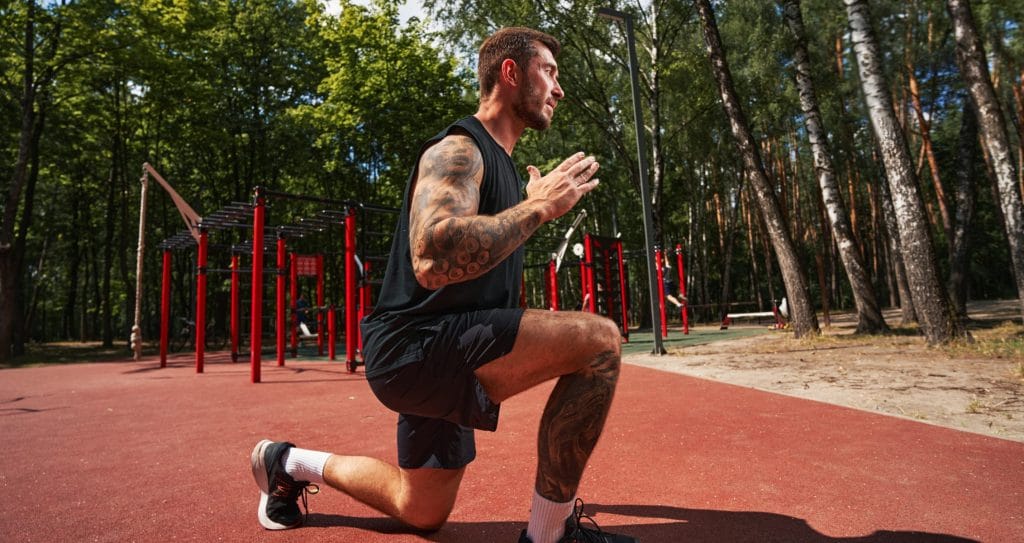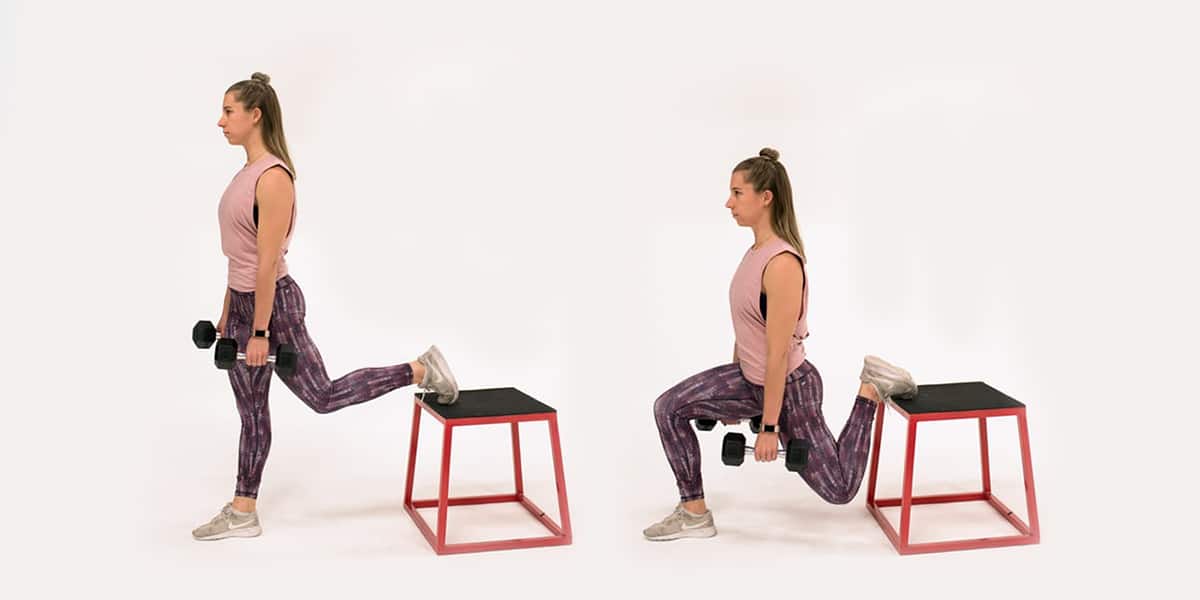Step up lunges improve your stability and quad and glute strength unilaterally.
Step ups are unilateral exercises that effectively strengthen your legs, focusing on sculpting your glutes. This routine offers a meticulous way to identify and correct imbalances between both sides, providing precise control as you alternate between limbs. Additionally, step ups engage your quads and hamstrings. (1) Now, imagine combining them with lunges.
Lunges also target and develop your lower body muscles, primarily emphasizing your quadriceps. Moreover, unlike step-ups, this exercise evenly distributes the weight between both legs. Notably, the forward lunge is often utilized in rehabilitation as it effectively strengthens critical muscles such as the hamstrings, quadriceps, and gastrocnemius. (2)
Step up lunges offer a perfect fusion of the step up and lunge exercises, delivering optimal muscle engagement and stability. Combining these movements can effectively improve your stabilizers and glute and quad strength. Let’s dive into how to perform set up lunges, the benefits, and alternatives below.
Techniques & Muscles Worked
Step up lunges work on your glutes, calves, hamstrings, abs, and obliques. (3) This exercise also emphasizes stabilizer muscles in your foot and knee and engages your core for stability. You can do step up lunges as a bodyweight exercise or add some resistance.
Step ups and lunges can be demanding on your stability as single exercises. When you combine them in a step up lunge, the demand is even more significant, so you need to start slowly and carefully. Follow the steps below to do step up lunges with proper form.
- Stand before a bench or box at knee level or below. Your feet should be shoulder-width distance apart and your arms by your sides. This is your starting position.
- Take your right leg back and kneel with it at 90 degrees. Your left leg in front should also be at 90 degrees.
- Next, come up with your right leg and step up on the bench with the same leg.
- Bring up your left leg, and then raise it by lifting your knee to chest level.
- Drop your left leg right next to the bench, then bring down your right leg to return to the starting position and complete your rep.
- Repeat for as many reps as you desire, then switch legs and do steps 2 to 5.
Benefits
The step up lunges unilaterally engage many lower body muscles and improve your stability. Below are some of the benefits of step up lunges.
Explode Lower Body Muscles
Step up lunges isolate and engage many lower body muscles. The step up hits your glutes primarily, while the lunge focuses on your quads. Although, your hamstrings and calves are activated as well.
Improve Stability
Working against gravity and focusing the load one leg at a time requires stability and balance. Step up lunges use your foot, leg, and core muscles to achieve the equilibrium that stops you from falling. Doing this exercise over time will strengthen those muscles, thus increasing your stability and balance.
Build Power
Step-ups can become a form of plyometric training that builds explosive power if you perform them fast enough. This will improve your athletic ability for running and jumping and carry over to Olympic movements like the snatch and power clean.
Fix Muscle Imbalances
Step up lunges are unilateral, so when using one leg at a time, you can check your strength in each one individually. If, in the process, you discover one leg is weaker, do a bit more reps with it when doing your routine. This will help you strengthen it to meet up with the other limb.
Strengthen Knee Joints
The step up lunge will strengthen the muscles around your knees as you move. It’s knee-friendly because you do a reverse lunge as part of the routine, which places less strain on your knees than a forward lunge.
Step Up Lunges Alternatives
The step up lunge is challenging, so start with the bodyweight version. However, you could introduce weights such as dumbbells, barbells, or kettlebells over time. Below are some other unilateral exercises that work on your lower body muscles.
Bulgarian Split Squat
The Bulgarian split squat is another unilateral exercise that uses a box or bench. It resembles a static backward lunge, but your back knee goes down from the box, giving it a deeper angle. This improves your range of motion and deepens your lower body muscles, especially the glutes and quads.
Single Leg Romanian Deadlift
Single leg Romanian deadlifts will test your stability and balance to the max. This one-legged deadlift variation is excellent for fixing muscle imbalances you would otherwise notice with the traditional variation.
Single Leg Mini Squat
The single leg mini squat focuses on the deep stabilizing muscles of the hips one leg at a time to help strengthen each leg individually, improving your stability and lower body development.
FAQs
What do step up lunges work?
Step up lunges work on your lower body and core muscles, emphasizing the quads and glutes. Check the guide above for a more detailed breakdown of the specific muscles in which this exercise works.
What are the benefits of doing lunges?
Lunges are great at working on the muscles that strengthen your knees. They’re also unilateral and can help you build your legs one at a time to correct imbalances.
How to do a step lunge?
To do a step up lunge, you first drop down into a backward lunge. When lifting your back leg from that, take it directly into a step up before returning to the starting position. Check out the more detailed step-by-step instructions above.
Follow us on Instagram, Facebook, and Twitter for more exercise guides!
References
- Simenz, C. J., Garceau, L. R., Lutsch, B. N., Suchomel, T. J., & Ebben, W. P. (2012). Electromyographical analysis of lower extremity muscle activation during variations of the loaded step-up exercise. Journal of strength and conditioning research, 26(12), 3398–3405. https://doi.org/10.1519/JSC.0b013e3182472fad
- Jönhagen, S., Halvorsen, K., & Benoit, D. L. (2009). Muscle activation and length changes during two lunge exercises: implications for rehabilitation. Scandinavian journal of medicine & science in sports, 19(4), 561–568. https://doi.org/10.1111/j.1600-0838.2007.00692.x
- Fischer, K. E., Walter, T., & Matovich, J. (2011). Exercise Technique: Reverse Lunge Into a Step-Up. Strength and Conditioning Journal, 33(2), 92–94. https://doi.org/10.1519/ssc.0b013e3182048e2e









